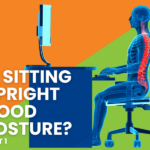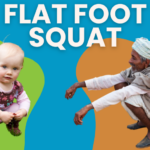This post has kindly been shared by Alison Richmond of Provention.
Shake up your work routine with frequent posture changes
While focusing on your daily tasks at your desk might seem like the best way to get things done, remaining in a static position for long periods can be detrimental to your health. They say, “the next posture is the best posture” for a reason. Incorporating regular movement into your workday isn’t just about feeling less stiff; it’s a powerful tool for enhancing both physical and mental well-being. In this article, we’ll explore the benefits of changing postures frequently and offer practical tips to seamlessly integrate movement into your daily routine.
Why Sitting Too Long Is Harmful
Let’s begin by understanding why sitting for extended periods is so harmful.
It’s obvious how staying in one position can cause muscular aches and strains, but the impacts go much deeper. Studies have shown that increased sitting time is linked to serious health issues like heart disease, diabetes, dementia, and even premature death. With ongoing research, this body of evidence continues to grow, highlighting the urgent need to rethink our sedentary habits.
Think about your daily routine. How often do you find yourself engrossed in work, only to realise hours have passed without moving? This lack of movement can lead to reduced blood flow, making you feel sluggish and reducing your productivity. But don’t worry, the solution is simple and accessible to everyone.
The Benefits of Moving More at Work
Incorporating small amounts of movement into your day can lead to big health benefits. Firstly, it helps maintain mobility and improve joint health, which is crucial for preventing long-term injuries. When you move, you increase blood flow to your muscles, which not only keeps them nourished but also reduces fatigue.
But the benefits aren’t just physical. Movement triggers the release of neurotransmitters such as dopamine and serotonin, which are responsible for feelings of happiness and well-being. You might be surprised at how a quick walk can boost your mood and enhance focus. Want to learn more about this? Read our article on Why walking is good for our brain
Even if you’re someone who exercises regularly outside of work, these small movements can still provide added benefits throughout the day.
Easy Ways to Add Movement to Your Day
Now that you’re aware of the importance of regular movement, let’s talk about how to incorporate it into your workday with minimal disruption to your tasks. One of the simplest methods is walking. Whether it’s a quick lap around the office or a stroll outside during your break, walking is an easy way to get moving. Opt for the stairs instead of the lift, even if it’s just for a couple of floors. These small changes can add up over time.
Additionally, consider having standing meetings. Not only do they encourage movement, but they can also lead to more efficient and productive discussions. At your workstation, make it a habit to move often. Perform big body movements to promote blood flow and relieve any stiffness you may feel. Remember, if you’re feeling uncomfortable, it’s your body’s way of telling you to change postures and move around a bit.
A Simple Rule: Move When You Feel Uncomfortable
A great rule of thumb to follow is simple yet effective: if you feel uncomfortable, change postures. This could mean stopping to move your body or taking a brief walk away from your desk.
Focus on movements that target key areas like your neck, shoulders, back, and hips. And move these body parts out of the position they have been in. For instance, if you have been sitting, stretch your arms backwards and open your chest or stand up and swing your legs backwards behind your hips.
Movements don’t have to be complex or time-consuming.
Simple actions like ‘marching on the spot’ and moving your hips and arms for 15 seconds is all you need. Most importantly, listen to your body. Becoming attuned to your physical needs can lead to a healthier lifestyle overall.
How to Build a Habit of Frequent Movement
Creating a habit of movement requires consistency. Try setting reminders on your phone or computer to prompt you to move at regular intervals. Incorporate movement into existing habits; for example, stand up and stretch every time you receive a phone call or finish a ‘task’
Over time, these actions will become second nature, ingrained in your daily routine. Remember, consistency is key to forming lasting habits that benefit your well-being.
Take Action: Start Moving Today
Ready to start moving more? Begin by implementing a few of the tips mentioned above.







